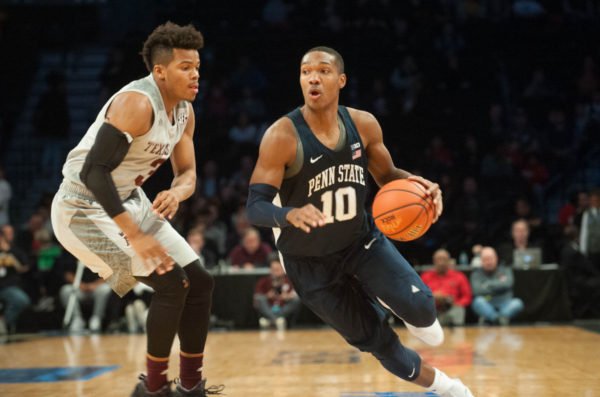For Penn State to Contend, Balance and Depth Will be Key
Posted by Tommy Lemoine on December 12th, 2017Penn State’s dismantling of George Washington on Saturday was Nittany Lion basketball at its finest: All five starters scored in double-figures; the defense wreaked havoc with its ¾ court press; and the team crashed the offensive glass with authority. Penn State led 48-19 at halftime and never looked back. “When we spread the ball and share the ball, we’re a really good basketball team,” head coach Pat Chambers said afterward. What Chambers’ team did not do on Saturday, though, was generate much contribution from its bench — especially on the offensive end. Nittany Lion reserves accounted for just seven of the team’s 74 points, which was actually an improvement from its previous two games combined. With its most talented lineup in years and a defense predicated on energy, Penn State’s ability to consistently distribute the wealth and develop quality bench depth may ultimately determine its ceiling.
Big Ten All-Freshman point guard Tony Carr has been nothing short of superb thus far, taking the “next step” in offensive production and efficiency many figured he would. The sophomore’s scoring average (20.0 PPG), offensive rating (119.4 ORtg), and three-point shooting (55% 3FG) are up substantially from a year ago, the result of an off-season commitment to improving his form. After a 31-point outpouring against Texas A&M, Aggies coach Billy Kennedy said of Carr, “I think he’s a pro; he’s good… he knows how to get to his spots anywhere.” And yet, outcomes like that one — a game in which Carr attempted 20 shots — might not be what’s best for Penn State, considering the complementary talent that surrounds him.
In the frontcourt, Lamar Stevens (13.7 PPG), who scored 25 in the lost to Texas A&M, possesses top-tier athleticism and is at his best when he has open lanes to attack the rim. Center Mike Watkins is quickly emerging as one of the conference’s elite big men. Flanking Carr in the backcourt are Shep Garner — a dangerous if streaky three-point shooter — and Josh Reaves (10.6 PPG), a defensive maven who’s already taken significant strides offensively. Penn State is at its best when Carr doesn’t have to force the issue, ball movement is sharp, and everyone is involved. That reality that has borne itself out in several of Penn State’s most efficient performances this season. In the team’s 31-point drubbing of Pittsburgh on November 20, six players scored in double figures and the Nittany Lions score a season-high 1.23 points per possession. In Penn State’s win at Iowa — its first since 2001 — good floor spacing enabled Carr, Stevens, Garner and Reaves to combine for 12-of-21 three-point shooting and Watkins to find favorable match-ups down low (19 points on 9-of-13 FG). “When we have balance, we’re tough to guard,” Chambers said over the weekend.
The win over Iowa, though, also underlined a recurring issue for Penn State: bench production (or lack thereof). In that contest, the starting five accounted for 100 percent of the scoring, and only one reserve played more than eight minutes. On the season, starters have accounted for 81 percent of all scoring, and even more against better competition. For Chambers, the need to find reliable bench contributors will be important on both ends of the floor. Penn State currently ranks seventh nationally in defensive steal rate, the product of aggressive trapping and relentless man-to-man defense. In order for steal-happy reserves like Nazeer Bostick and Jamari Wheeler to see the floor, they need to prove capable of holding their own offensively. Each has had their moments (especially Bostick, who is averaging 5.9 PPG in 17.9 MPG), but both must continue improving in order to stay on the floor, keep Carr fresh, and help Chambers’ defense maintain its aggression for 40 minutes. An even bigger depth issue lies in the frontcourt, where Watkins is emerging as an irreplaceable star, averaging 12.6 points, 8 rebounds, and 3.7 blocks per game. His Defensive Box Plus/Minus (+9.2) is 14th-best in the country, an indicator of just how dominant — and important — he is on that end. Coming into the season, the hope was that seven-foot Virginia Tech transfer Satchel Pierce would be a serviceable fill-in for Watkins when he was out of the game. To this point, that hasn’t played out; Pierce, who hasn’t seen floor since the Iowa game, has seemingly fallen out of favor with Chambers. Although Watkins is proving himself capable of playing 35+ minutes a night, Penn State will need to find someone — whether it be Pierce or freshmen Trent Buttrick and John Harrar — capable of providing quality minutes when the big man sits.

Tony Carr has been great, but Penn State’s at its best when others are involved. (Christopher Sanders, The Daily Collegian)
For Chambers, the path to success is really quite clear: “Our identity needs to be defense and rebounding,” the seventh-year coach said on Saturday. And so far, it is; Penn State currently boasts the 18th-stingiest defense in college basketball and ranks among the top-50 in offensive rebounding rate. Still, for the Nittany Lions to break through as a legitimate Big Ten contender and compete for its first NCAA Tournament birth since 2011, it’s going to take more than just gritty defense and hard-nosed effort on the glass. It’s going to take better ball-movement, more balanced offense, and improved stamina. Early returns to that end suggest they’re on the right track; Penn State’s Adjusted Offensive Efficiency (109.1) is up substantially from 2016-17 (104.5). Whether it can keep pace and avoid another late season slide, on the other hand, remains to be seen.









































